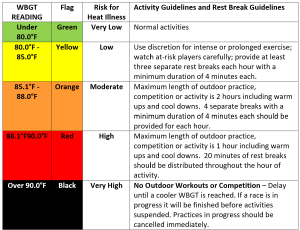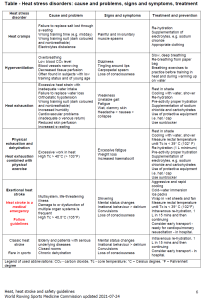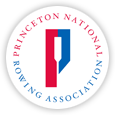Adopted: October 28, 2024
Heat stress is a serious health risk. High intensity exercise in a hot environment, with the associated fluid loss and elevation of body temperature, can lead to dehydration, heat exhaustion and heat stroke (which can be fatal). High humidity significantly increases the likelihood of heat stress. Children are at greater risk than adults are because their thermoregulation mechanisms are not fully developed. Older athletes can also be at high risk because of reduced cardiac function.
Competition and practice organizers have a Duty of Care to monitor environmental conditions and to take action to minimize the risk of heat stress to athletes.
1. Scope of these Recommendations
These recommendations shall apply to all competitions and practices conducted by the Princeton National Rowing Association, Mercer Rowing Programs on Mercer Lake or run out the Caspersen Rowing Center.
2. Structure of the Extreme Heat Recommendations
These recommendations are divided into sections:-
- Activating the Extreme Heat Recommendations
- Wet Bulb Globe Temperature (WBGT)
- Requirements of the Competition Manager/Event Director/Coaches
- Recommendations to Executive Director/Programs Manager/Event Manager
- Important Information – and who suspends racing/practice
- Measuring the Wet Bulb Globe Temperature
- Procedures for reducing the risk of heat stress
- Medical Issues Relating to Heat Stress
3. Activating the Extreme Heat Recommendations
The following minimum requirements will determine activation of the Extreme Heat Recommendations.
The Wet Bulb Globe Temperature should be taken at the Caspersen Rowing Center on the side of the course in direct sunlight with an appropriate measuring device (e.g. Extech Heat Stress WBGT HT30) or taken from an online source which reports on local Wet Bulb Globe Temperatures (e.g. the Zelus WBGT app set to NJ NJSIAA).
The WBGT must be checked when the ambient temperature is 85°F or higher. Once this threshold is met, the WBGT should be checked a minimally every hour until the ambient temperature is below 85°F or a WBGT that has reached the Moderate zone returns below 85.1°F or the activities are completed/stopped.

(Table adopted from New Jersey State Interscholastic Athletic Association)
4. Wet Bulb Globe Temperature (WBGT)
The Heat Index was developed as a measurement of ambient temperatures and relative humidity while resting in the shade. It is intended to provide outdoor restrictions for the elderly and adolescents during times of elevated temperatures. It is not relevant to a athletic activity settings.
The WBGT is a measurement of ambient temperature, relative humidity, radiant heat from the sun and wind speed. When outdoor activities are conducted in the direct sun, the WBGT is the most pertinent to use. Rowing is an outdoor sport which generally takes place on a body of water in direct sun.
Although read in degrees, the WBGT does not reflect degrees of air temperature. A WBGT reading of 92 F may equate to a Heat Index reading of 104-105 degrees F.
5. Requirements of Executive Director/Programs Manager/Event Manager/Coaches
- The Zelus app installed on a mobile devise to monitor the WBGT or access to a tool that measures WBGT (e.g. Extech Heat Stress WBGT HT30) at Mercer Lake and the Caspersen Rowing Center.
- Once the ambient air temperature reaches 85°F, the conditions must be evaluated at least once every hour.
- Once the Extreme Heat Recommendations are invoked, the conditions must be re-evaluated every 30 minutes.
- Where practice or racing is suspended, Executive Director/Programs Manager/Event Manager/Coaches must ensure that all competitors, coaches and managers involved in the regatta are made aware of the action.
- Once the Extreme Heat Recommendations are invoked, the Executive Director/Programs Manager/Event Manager/Coaches must ensure that the minimum rest time between practices or races is one hour.
- Cold drinking water should be made available.
- Cold showers and misters should be made available.
- Ice and ice baths should be made available for heat stress emergencies.
- Adequate shaded areas should be provided.
- The Executive Director/Programs Manager/Event Manager/Coaches closest advisor on medical matters is PNRA’s Medical advisor or in the case of an event the onsite EMT’s .
- In the case of a heat related medical emergency – 911 should be called.
- Promote awareness of the seriousness of heat stress and the steps that can be taken to reduce the danger by displaying and distributing appropriate information such as the “Drink Up – Beat the Heat” leaflet. The “Beat the Heat” Recommendations as included in the Extreme Heat Recommendations should also be displayed at the Caspersen Rowing Center and at regatta venues.
Note: A coach or a referee at an event will consult with the Executive Director/Programs Manager/Event Manager and may invoke the Extreme Heat Recommendations if he/she believes there is real danger to the competitors’ health.
6. Recommendations to Executive Director/Programs Managers/Event Managers
- Have cold water drinking fountains available.
- Have showers or misters available.
- Encourage competitors to wear hats that cover the top of the ears and back of the necks.
- Avoid scheduling practices and races in the middle of the day when the risk of heat stress is highest. Consider modifying racing distances or practices accordingly.
7. Important Information and who suspends practice or racing
- Any coach may suspend practice on account of the weather conditions and may invoke the Extreme Heat Recommendations if he/she believes there is real danger to the participant’s health.
- In the case of a regatta, Referee has the power to suspend racing or postpone any race on account of the weather conditions. The Referee will consult with the chief referee and regatta director and may invoke the Extreme Heat Recommendations if he/she believes there is real danger to the competitors’ health.
- The measurement values used in the Extreme Heat Recommendations determine the level of risk are for an average person involved in continuous strenuous activity in high temperatures. Individual persons will be affected differently by the environmental conditions depending on their:
Fitness level
Athletic ability
Age
Gender
Any predisposed medical conditions
Level of acclimatization
8. Instruments for measuring Heat Index
The ambient air temperature at the Caspersen Rowing Center should be measured using the boathouse weather station whose reading are available at www.rowpnra.org. If the weather station is not available then an internet reporting service that reports the conditions in West Windsor, NJ.
The Wet Bulb Globe Temperature should be taken at the Caspersen Rowing Center on the side of the course in direct sunlight with an appropriate WBGT measuring device (e.g. Extech Heat Stress WBGT HT30) The WBGT may also be taken from an online source which reports local WBGTs. The preferred online source in the Zelus WBGT app set to NJ NJSIAA.
9. Procedures for Reducing the Risk of Heat Stress
BEAT THE HEAT
High intensity exercise in a hot environment, with the associated fluid loss and elevation of body temperature, can lead to Dehydration, Heat Exhaustion and Heat Stroke.
AVOID HEAT STRESS BY ADEQUATE FLUID REPLACEMENT.
- Racing in hot weather will result in extra fluid loss (dehydration). Even small degrees of dehydration will cause a decrease in performance and this can occur at any stage of a competition, particularly in hot conditions.
- Dehydration contributes to fatigue and may make you more susceptible to cramps, heat stress and heatstroke.
- Children are at a greater risk of heat stress than mature adults.
‘BEAT THE HEAT’ USING THE FOLLOWING MEASURES WHAT TO WEAR
- Wear a hat, cap or visor – a broad brimmed hat is preferred.
- Wear a 30+ sunscreen to prevent skin damage and skin cancer.
- Wear sunglasses to protect your eyes.
- Replace sweat-saturated garments with dry clothing.
DRINK PLENTY OF WATER
- Do Not Wait To Feel Thirsty Before You Drink!
- Sweat is mainly water and a very little salt.
- Drink cool water as it is absorbed more rapidly than warm water.
- If competing for more than one hour, use such as Gatorade or PediaLyte. (salt tablets should be avoided because of their very high sodium chloride content, which can make dehydration worse).
- Thirst is a poor indicator – it is a late signal of severe fluid loss.
- Soft drinks, especially those with caffeine do not rehydrate and should not be used
FLUID REPLACEMENT ROUTINE
- Avoid starting exercise dehydrated (drink plenty of fluids for several hours prior to participating).
- Drink at least 500 ml (2-3 glasses) ½ to 1 hr before a race.
- Drink at least 500 ml to 1 litre (5-6 glasses) after a race and continue to drink until fluid losses are replaced.
9. Medical Issues Relating to Heat Stress
a. Dehydration
Dehydration occurs when one loses more fluid than it is taken. The body doesn’t have enough water and other fluids to carry out its normal functions. Symptoms of dehydration are thirst, dark-coloured urine, fatigue, dizziness, and confusion. Dehydration may cause heat injury, urinary and kidney problems, seizures, and low blood volume shock (hypovolemic shock).
b. Heat Cramps
Heat cramps are painful, involuntary, brief muscle spasms that usually occur during heavy exercise in hot environments. Fluid and electrolyte loss often contribute to heat cramps.
c. Heat Exhaustion
Exposure to high temperatures, particularly when combined with high humidity, and strenuous physical activity, can lead to body overheating causing heat exhaustion. Possible heat exhaustion signs and symptoms include:
- cool, moist skin,
- heavy sweating,
- faintness,
- dizziness,
- fatigue,
- weak, rapid pulse,
- low blood pressure upon standing,
- muscle cramps,
- nausea and
- headache.
Without prompt treatment, heat exhaustion can lead to heat stroke, a life-threatening condition.
d. Exertional Heat Stroke
Exertional heat stroke is a medical emergency defined as life-threatening hyperthermia (core body temperature ≥ 40.5°C (105°F)) and central nervous system (CNS) dysfunction (encephalopathy) and additional organ and tissue damage (e.g. acute kidney injury, liver injury, rhabdomyolysis). It is one of the top three causes of sudden death in athletes. Morbidity and mortality are more strongly linked to duration, rather than degree, of hyperthermia; hence, the “cool first, transport second” principle should be applied.
Heat related illnesses should be taken very seriously and appropriate levels of care given, including with trained medical personal – if needed call 911.
Sources:
- Heat Participation Policy, New Jersey State Interscholastic Athletic Association https://www.njsiaa.org/sites/default/files/documents/2020-10/njsiaa-heat-participation-policy-080619.pdf
- World Rowing Hot Weather and Heat Safety Guidelines (updated 26/07/2021); World Rowing Sports Medicine Commission
- Wet Bulb Globe Temperature Monitoring https://koreystringer.institute.uconn.edu/wet-bulb-globe-temperature-monitoring/

